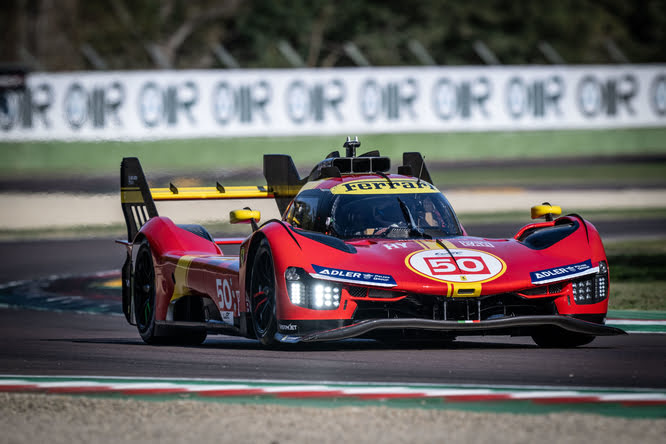By Carlo Platella
The great international Endurance returns to Imola, a facility at odds with that of Monza which hosted the recent editions of the Italian stage of the WEC. It will be staged in Emilia-Romagna an atypical race compared to the usual dynamics of Endurance, where a competitive race pace will not be a guarantee of success. Santerno instead turns the spotlight on the flying lap in qualifying and on the management of the very delicate pit stop phases, anticipating a headache-inducing race for the strategists.
Track position priority
Monte Carlo is to Formula 1 what Imola is to the WEC. A comparison that may be difficult to digest, but which arises from the great difficulties in overtaking for cars with covered wheels. Santerno is a difficult track for overtaking even for Formula 1, but the difficulties are exacerbated for Hypercars, without DRS and with a low range slip effect. The particularly narrow roadway will make the dubbing phases of the GTs are also complexwhich could offer the few opportunities to catch the opponent by surprise and gain a position.
Faced with this scenario, the position at the start will be crucial, placing great emphasis on qualification. Already in Qatar we saw that the car is not all about the flying lap, with Toyota surprisingly capable of grabbing the front row with Nyck de Vries. The preparatory laps for the attack on the time will be decisive, trying to bring the tires into the correct temperature window and then exploiting the only lap in which grip reaches its peak. A very delicate practice, where exit timing and traffic management also come into play.
In the race, however, the opportunities to gain positions will arise during the pit stops. Extending the life of the tires will be fundamental, trying to get to three consecutive stints both to reduce the time lost during replacement and in subsequent warm-up laps. A difficult undertaking, but not prohibitive, given that Michelin brings the hardest compounds in the range. Added to all this is the variable of the Safety Car, whose entry is decidedly probable on a narrow track where the risk of contact is high.
Curbs to digest
In Imola there are many factors potentially capable of reshuffling the balance of power, without necessarily bringing everything back to the Balance of Performance alone. The Italian track is the opposite of that of Lusail which hosted the start of the world championship, with a tortuous design and short straights, which overshadow the aspect of top speed. There are plenty of slow curves that shift the focus on traction qualities, such as the variations, the Tosa hairpin and the double Rivazza. Not to be overlooked are the bumps in the asphalt and above all the need to attack the high curbs of the track, in particular at the Variante Gresini, turning the spotlight on the mechanical behavior of the cars.

Jonathan Diguid, Managing Director of Porsche Penske Motorsport, is aware of this: “In Lusail I think I found the most regular and smooth asphalt I've ever seen in my life and therefore we were able to run really 'low' with the car”, the words reported by Sportstcar365. “In Imola, however, there will be many more bumps, bumps and curbs, a cross between a 'smooth' and bumpy circuit like Sebring or Long Beach.”
Precisely in the recent 12 hours of Sebring, Porsche still seemed a little too aerodynamically sensitive to the more irregular asphalts, which impose higher and above all more unstable ground clearances. So far, however, Cadillac has managed this aspect better, keeping in mind that both companies boast greater experience in these contexts, also racing on the American IMSA tracks.
Toyota – Ferrari, the challenge is renewed
Imola is probably the most limiting track for all-wheel drive Hypercars, as there are no fast enough corners where the front electric motor can be activated. Ferrari starts from a lighter minimum weight than Toyota, with 19 kg less assigned by the BoP. All this will help the 499P to take care of the tyres, after the excellent tire management shown in Qatar, when the Reds improved their times throughout the stint. Toyota for its part suffers from yet another weight handicap, necessary to compensate for the greater aerodynamic load, a rewarding quality on the most tortuous and traction circuits, such as that of Imola.

The underdogs are therefore divided between Ferrari, Toyota, Porsche and Cadillac, i.e. the manufacturers that already boast over a year of experience in the World Championship. The exception is Peugeot, for which the Italian race will be a sort of second debut with the revolutionized 9X8, arousing great curiosity towards the performance of the French hypercar. For Alpine, BMW, Lamborghini and Isotta Fraschini, however, the imperative will be to reach the finish line and collect data, while remaining ready to exploit any unforeseen events that should happen to the top competition.
#WEC #Monaco #keys #hours #Imola